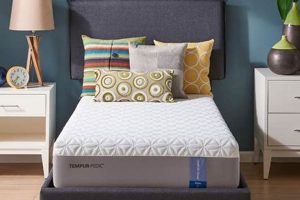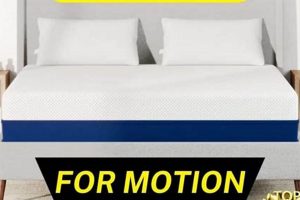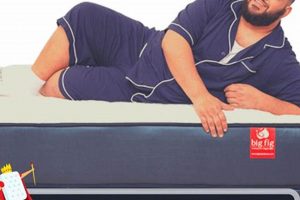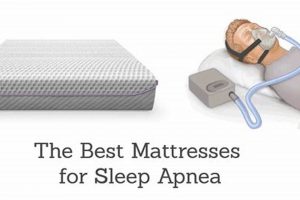An optimal sleep system integrates a supportive sleeping surface with a powered foundation, offering customizable positioning for enhanced rest. This combination allows individuals to modify the angle of the head and legs, potentially improving comfort and addressing specific health concerns. For instance, elevating the upper body can alleviate snoring and acid reflux, while raising the lower extremities may improve circulation.
The adoption of these adjustable systems has seen considerable growth due to their potential for therapeutic benefit and lifestyle enhancement. Historically, such beds were primarily utilized in hospital settings, but advancements in technology and design have made them increasingly accessible for home use. The benefits extend beyond medical applications, offering personalized comfort for activities such as reading, watching television, or working from bed.
The subsequent discussion will explore critical factors to consider when selecting an appropriate sleep system, including mattress compatibility, motor quality, available features, and warranty provisions. Further, it will delve into the various advantages and disadvantages associated with these systems, providing a comprehensive understanding for informed decision-making.
Essential Considerations for Optimal Sleep System Selection
This section outlines key considerations to ensure a compatible and beneficial choice, facilitating informed decision-making.
Tip 1: Assess Mattress Compatibility: Verify the mattress is designed for use with an adjustable base. Memory foam and latex mattresses generally offer greater flexibility and conformability than traditional innerspring models. Consult manufacturer specifications to confirm compatibility.
Tip 2: Evaluate Motor Quality and Noise Levels: Prioritize systems featuring robust, low-noise motors. Excessive noise can disrupt sleep. Seek models with decibel ratings below 50dB for quieter operation.
Tip 3: Examine Range of Motion and Positioning Options: Determine the desired range of motion for head and foot elevation. Consider models offering pre-set positions like zero-gravity or anti-snore, or the capacity to customize and save preferred settings.
Tip 4: Review Weight Capacity and Stability: Confirm the system’s weight capacity accommodates all intended users, including the mattress. A robust frame and stable legs are crucial for safety and longevity.
Tip 5: Investigate Available Features: Evaluate optional features such as massage functions, USB charging ports, under-bed lighting, and remote controls. Consider the utility and value of these features based on individual needs and preferences.
Tip 6: Scrutinize Warranty Provisions and Return Policies: Carefully review the warranty coverage, including the duration and specific components covered. Understand the manufacturer’s return policy and any associated restocking fees. A comprehensive warranty provides assurance of quality and protects against potential defects.
Careful consideration of these factors ensures a selection that aligns with individual needs, promotes restful sleep, and maximizes the potential benefits of a powered sleep system.
The subsequent sections will delve into common challenges and potential issues associated with these systems, offering guidance on troubleshooting and maintenance.
1. Mattress Compatibility
Mattress compatibility represents a foundational element in the successful integration of a sleep system. The selection of an incompatible mattress negates the potential benefits, diminishing the overall value of the adjustable foundation and hindering sleep quality.
- Flexibility and Articulation
The ability of a mattress to conform to the contours of the adjustable base is paramount. Materials like memory foam and latex possess superior flexibility, allowing them to bend without compromising structural integrity. Conversely, traditional innerspring mattresses with rigid coil systems may not adequately conform, potentially leading to uneven support and accelerated wear. In a hospital setting, this could limit the efficacy of pressure relief for bedridden patients.
- Material Durability Under Stress
Repeated articulation of a mattress on a powered foundation induces stress on the mattress materials. Mattresses constructed with high-density foams and reinforced seams are better equipped to withstand this constant movement, maintaining their shape and support over time. In contrast, mattresses with lower-quality materials may exhibit premature sagging or deformation, resulting in reduced comfort and lifespan. Within home healthcare, a lack of durability could necessitate more frequent mattress replacements.
- Weight Distribution and Support
Adjustable bases alter the distribution of weight across the mattress surface. Mattresses designed with zoned support systems, featuring targeted areas of firmness, can effectively accommodate these shifts in pressure. This ensures consistent support regardless of the adjusted position, preventing pressure points and promoting spinal alignment. Failure to properly distribute weight can lead to discomfort and potential musculoskeletal issues. For example, users who tend to sleep on their back benefit from specialized lumbar support.
- Thickness and Profile Considerations
The thickness and profile of the mattress can impact its compatibility with the base. Excessively thick mattresses may hinder the base’s range of motion, while overly thin mattresses may lack adequate cushioning and support. A balanced profile ensures optimal performance and comfort. In an elderly care facility, a well-matched profile may reduce risks for users who require assistance getting in and out of bed.
Therefore, a thorough assessment of mattress composition, construction, and specifications is imperative when selecting a component for optimal pairing. Neglecting this critical aspect undermines the potential advantages, emphasizing the importance of comprehensive consideration when choosing a sleep system.
2. Motorized Adjustability
Motorized adjustability forms a core functional element, defining the capabilities and benefits associated with a sleep system. Without a robust and reliable motor system, the potential for personalized comfort and therapeutic positioning is severely limited. The quality and performance of the motor directly influence the range of motion, the smoothness of transitions, and the overall user experience. A substandard motor can exhibit excessive noise, sluggish responsiveness, or even premature failure, thereby negating the investment in an adjustable foundation. For example, a motor with insufficient power might struggle to elevate a heavier individua
l, rendering the positioning feature ineffective.
The integration of motorized adjustability enables users to tailor the bed’s configuration to address specific needs. Elevating the head and torso can alleviate symptoms of acid reflux or sleep apnea, while raising the legs can improve circulation and reduce swelling. These adjustments contribute to enhanced comfort for activities such as reading, watching television, or working from bed. Furthermore, pre-programmed positions, such as zero-gravity or anti-snore settings, offer convenient options for optimizing sleep quality. In practical terms, a system with precise and dependable motorized control allows for micro-adjustments, enabling users to fine-tune their sleeping posture for maximum comfort and support.
In summary, motorized adjustability is not merely a feature but an essential component of a functional and effective adjustable sleep system. The reliability, power, and precision of the motor directly impact the user’s ability to customize their sleep environment and realize the potential therapeutic benefits. Therefore, careful consideration of motor quality and performance is paramount when selecting a system to ensure long-term satisfaction and optimal sleep experience. A compromised motor system undermines the functionality, emphasizing the critical interdependence between the base and the adjustability functionality.
3. Frame Durability
Frame durability is a critical determinant of the overall lifespan and functionality of an adjustable sleep system. The frame provides the structural foundation that supports the weight of the mattress and occupants, while also withstanding the stresses associated with repeated articulation. A lack of durability can lead to premature wear, instability, and eventual failure of the entire system. The connection between frame integrity and the definition of a sleep system lies in the fact that a weak or poorly constructed frame compromises the adjustability function, regardless of the quality of the other components. As an illustration, if the frame buckles under the weight of the mattress and a sleeper, the motorized adjustments become ineffective, rendering the primary purpose of the adjustable base moot. A robust frame made of high-quality steel, with reinforced joints and stable legs, is essential for supporting the weight and handling the movement. It ensures proper weight distribution, preventing sagging or deformation of the mattress and providing a stable surface for the sleeper.
Consider a real-world scenario: a patient requiring elevated leg support to manage edema. If the frame supporting the system lacks sufficient strength, the repeated raising and lowering of the leg section could cause the frame to warp or bend over time. This not only compromises the functionality of the adjustable base but also creates a safety hazard, as the uneven support could lead to discomfort or injury for the patient. High frame durability translates directly to greater longevity and a lower risk of mechanical failure, reducing the long-term cost of ownership. The implications extend beyond mere financial considerations; a durable frame ensures consistent support and comfort, contributing to improved sleep quality and overall well-being.
In summary, frame durability is an indispensable attribute. Compromises in frame strength can negate the advantages of other components, leading to functional limitations and potential safety hazards. Prioritizing a robust frame ensures long-term reliability, consistent support, and overall satisfaction. The strength and construction of the frame serve as a foundational element, directly impacting the usefulness and lifespan of the adjustable sleep system.
4. Feature Integration
Feature integration significantly impacts the perceived value and functional utility of an adjustable sleep system. The incorporation of supplemental features, such as massage functionality, USB charging ports, under-bed lighting, and remote control options, can enhance the overall user experience and contribute to a more holistic and convenient sleep environment. These integrated features must be evaluated not merely as superfluous additions but as integral components that augment the core adjustability function. Consider the practical application of a USB charging port integrated into the base; this eliminates the need for bedside tables cluttered with charging cables and power adapters, promoting a cleaner and more organized sleep space. Similarly, under-bed lighting serves a functional purpose, providing illumination for nighttime navigation without disrupting sleep cycles by activating bright overhead lights. These examples illustrate how thoughtful feature integration can address practical needs and elevate the user’s overall experience.
The effectiveness of feature integration hinges on the seamless and intuitive implementation of these supplemental components. A poorly designed remote control, for instance, with an unintuitive interface or unreliable connectivity, can detract from the overall user experience and diminish the perceived value of the system. Furthermore, the quality and durability of integrated features must be considered. Low-quality massage motors or flimsy USB ports are prone to failure, leading to user dissatisfaction and potentially negating the benefits of the adjustable base. A well-integrated system ensures that supplemental features function harmoniously with the adjustability function, enhancing the overall utility and value of the system. For example, a system with customizable massage settings coordinated with adjustable positioning can offer targeted relief for specific areas of discomfort.
Effective feature integration requires a holistic design approach that prioritizes user needs, functionality, and reliability. The selection of these supplementary attributes should be aligned with the intended purpose and target demographic of the adjustable sleep system. Careful consideration must be given to the user interface, durability, and potential impact on the core adjustability function. Failure to integrate features thoughtfully can lead to a disjointed and unsatisfactory user experience, undermining the value of the investment. By prioritizing thoughtful feature integration, manufacturers can create adjustable sleep systems that not only provide personalized comfort and support but also enhance the convenience and overall quality of the sleep environment.
5. Warranty Coverage
Warranty coverage is an essential attribute to consider when evaluating an adjustable sleep system. It functions as a safeguard against manufacturing defects and premature component failure, thereby providing financial protection and ensuring long-term satisfaction with the product. The robustness of warranty terms directly impacts the perceived value and risk associated with such a purchase. For instance, a comprehensive warranty covering both the frame and motorized components for a period of several years offers significantly greater peace of mind compared to a limited warranty with restricted coverage. The adjustable nature of these systems introduces complexities beyond those associated with traditional mattresses and foundations; consequently, a suitable warranty addresses the unique potential points of failure
. A limited warranty, conversely, may only cover specific components or offer reduced coverage periods, potentially leaving the consumer responsible for repair or replacement costs arising from component malfunction.
The type of coverage offered, the duration of the coverage, and the specific components included under the warranty represent critical factors to evaluate. A comprehensive warranty typically encompasses the frame, motor, electrical components, and even upholstery, safeguarding against a broad range of potential issues. Furthermore, the claims process and the manufacturer’s responsiveness to warranty requests are indicative of the level of support provided. Delays in processing claims or difficulties obtaining replacement parts can lead to significant inconvenience and dissatisfaction. Consider a scenario wherein a motor malfunctions shortly after the standard warranty period has expired. The cost of replacing the motor could be substantial, particularly if specialized technicians or components are required. A more extensive warranty would have covered this expense, preventing a significant financial burden.
In conclusion, warranty coverage represents a vital consideration, as it directly impacts the long-term cost of ownership, the level of protection against potential defects, and the peace of mind associated with the purchase. Evaluating warranty terms requires careful attention to detail, considering the scope of coverage, the duration of protection, and the manufacturer’s reputation for honoring warranty claims. Investing in a product with a comprehensive warranty mitigates risk and ensures a higher level of satisfaction. While it is not the sole factor driving purchase decisions, it is a critical aspect to weigh when investing in a long-term sleep solution.
6. Position Customization
Position customization is a core function intrinsically linked to the benefits provided by an adjustable sleep system. It moves beyond the concept of a static sleeping surface, providing users with the ability to modify the angle and configuration of the bed to address individual needs and preferences. The degree and precision of position customization directly influence the comfort, therapeutic benefit, and overall satisfaction derived from the sleep system.
- Individualized Comfort and Support
Position customization enables users to fine-tune the bed’s configuration to achieve optimal comfort and support for specific activities, such as reading, watching television, or working from bed. Elevating the upper body can reduce strain on the neck and back, while raising the legs can alleviate pressure on the lower spine. The potential impact is significant for users who spend extended periods in bed due to medical conditions or lifestyle choices. For example, a remote worker can adjust the bed to a semi-reclined position, providing ergonomic support for prolonged periods of computer use.
- Therapeutic Applications and Health Benefits
Position customization offers significant therapeutic advantages for individuals with specific health concerns. Elevating the head can alleviate symptoms of acid reflux and sleep apnea by reducing pressure on the esophageal sphincter and improving airflow. Raising the legs can improve circulation, reduce swelling, and alleviate discomfort associated with varicose veins or edema. In a hospital setting, position customization is crucial for promoting patient comfort, preventing pressure ulcers, and facilitating respiratory function. Adjustable positioning supports a range of patient needs that traditional static beds cannot accommodate.
- Pre-set Positions and Programmable Options
Many adjustable sleep systems offer pre-set positions, such as zero-gravity or anti-snore, which provide convenient options for optimizing sleep quality. Zero-gravity positioning evenly distributes weight across the body, reducing pressure on joints and muscles. Anti-snore positioning elevates the head, improving airflow and reducing snoring. Programmable options enable users to save preferred positions, allowing for quick and easy access to personalized comfort settings. This is particularly useful for individuals with recurring conditions or specific positioning requirements. Consider a senior citizen with arthritis; personalized settings for rest and relaxation would provide a consistent level of comfort.
- Range of Motion and Adjustability Precision
The range of motion and adjustability precision directly impact the potential benefits of position customization. Systems with a wider range of motion and finer adjustment increments offer greater flexibility and control over the bed’s configuration. This allows users to fine-tune their sleeping posture to achieve optimal comfort and support. For example, a system with independent head and foot articulation enables users to adjust each section individually, catering to unique body contours and preferences. Such granular control over positioning contributes to a more personalized and effective sleep experience.
The capacity for precise and individualized position customization is a key determinant of its value. The therapeutic potential and lifestyle enhancements offered through variable bed configurations ultimately rely on achieving optimum comfort and effective medical support. It is this integration that defines a successful sleep system.
Frequently Asked Questions
This section addresses common inquiries regarding adjustable mattress bases, providing objective information to aid in informed decision-making.
Question 1: What mattress types are most compatible with an adjustable base?
Memory foam and latex mattresses generally exhibit superior flexibility and conformability, enabling them to articulate effectively with an adjustable base. Traditional innerspring mattresses may not conform as readily, potentially leading to uneven support and accelerated wear. Hybrid mattresses incorporating both foam and coil components should be evaluated on a case-by-case basis.
Question 2: Is a specialized sheet set required for use with an adjustable base?
While standard sheet sets can be used, deep-pocket sheets with elasticized edges may provide a more secure and conforming fit, minimizing the risk of slippage or bunching during adjustments. Some manufacturers offer sheet sets specifically designed for adjustable bases, featuring enhanced elasticity and reinforced seams.
Question 3: How does the weight capacity of an adjustable base affect its performance and longevity?
Exceeding the stated weight capacity of an adjustable base can compromise its structural integrity, leading to premature wear, instability, and potential mechanical failure. It is crucial to select a base with a weight capacity that accommodates the combined weight of the mattress and all intended users.
Question 4: What are the potential drawbacks associated with an adjustable base?
Adjustable bases typically command a higher price point than traditional foundations. Furthermore, the added complexity of motorized components increases the potential for mechanical or electrical malfunctions. The weight of an adjustable base can also present challenges during relocation or setup.
Question 5: Can an adjustable base be used with an existing bed frame?
Compatibility with existing bed frames varies depending on the design and dimensions of both the base and the frame. Some adjustable bases are designed to be used independently,
while others are intended to fit within a standard bed frame. Careful measurement and consideration of mounting options are essential to ensure proper integration.
Question 6: What is the significance of motor noise levels in an adjustable base?
Excessive motor noise can disrupt sleep and detract from the overall comfort of an adjustable base. It is advisable to select a model with a low decibel rating (typically below 50dB) to ensure quiet operation during adjustments.
The above provides a foundation for better decision-making.
The next section will delve into troubleshooting common issues associated with adjustable bases.
In Conclusion
This exposition has detailed the multifaceted considerations surrounding sleep systems featuring an adjustable foundation. From assessing mattress compatibility and scrutinizing motor quality to evaluating warranty provisions and feature integration, the selection process demands comprehensive due diligence. Understanding the interplay between these elements empowers consumers to make informed decisions, optimizing the potential benefits of an adjustable sleep system.
The pursuit of restorative sleep warrants careful deliberation, given the profound impact on overall well-being. Investing in an appropriate system requires aligning individual needs with product capabilities, acknowledging the long-term implications for health and lifestyle. As technology evolves, continued advancements in design and functionality promise enhanced customization and therapeutic potential within the realm of adjustable sleep systems, yet these advancements should be evaluated in light of enduring factors, such as durability and user-friendliness, to maximize user satisfaction.


![Top Rated: Best Infant Mattress [Guide & Reviews] Organic & Natural Mattress Buyer’s Guide: Non-Toxic Sleep Solutions Top Rated: Best Infant Mattress [Guide & Reviews] | Organic & Natural Mattress Buyer’s Guide: Non-Toxic Sleep Solutions](https://mattressworldpa.com/wp-content/uploads/2025/07/th-7676-300x200.jpg)


![Top Best Mattress Brands of [Year]: Sleep Soundly! Organic & Natural Mattress Buyer’s Guide: Non-Toxic Sleep Solutions Top Best Mattress Brands of [Year]: Sleep Soundly! | Organic & Natural Mattress Buyer’s Guide: Non-Toxic Sleep Solutions](https://mattressworldpa.com/wp-content/uploads/2025/07/th-7673-300x200.jpg)

